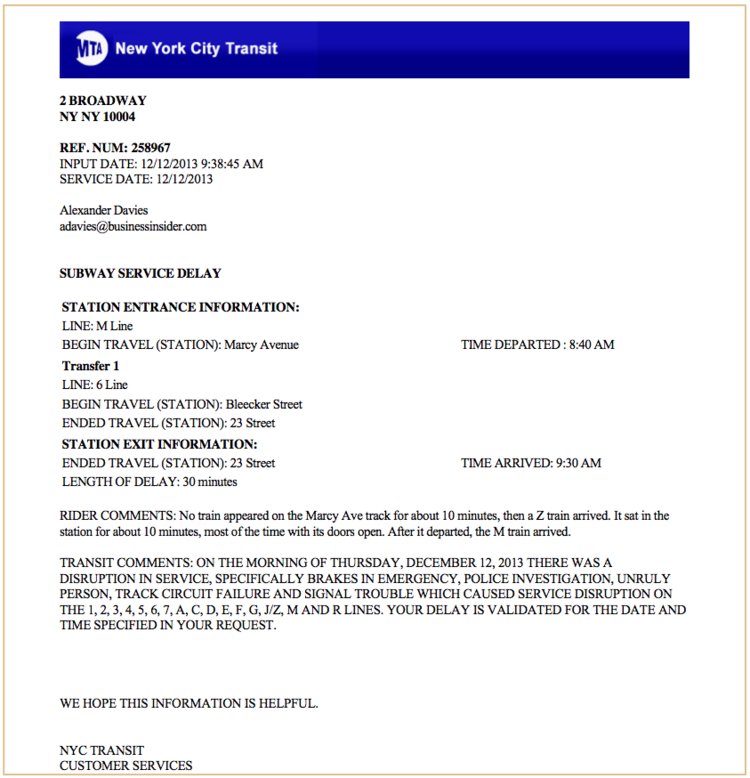New York City’s Late Pass
For those who work in major cities, public transportation is critical to the commute — it is often the only way for you to get from your house to your job in a reasonable amount of time. As a result, when it fails you, there’s a problem: no matter where you’re going, you’re going to be late.
If you’re in or around New York City, this has become an increasingly common problem. Over the years, NYC’s subway system has earned a bad reputation — lots of delays, overcrowding, and other problems have provided no end to complaints and concerns about the health of public transport in the city. The Metropolitan Transit Authority (MTA) offers some stats which suggest that things are actually improving, but an independent review in 2017 by the New York Times concluded otherwise, noting that “subway delays have jumped to more than 70,000 each month, from about 28,000 per month in 2012.” And some believe the city’s system is on the cusp of an ominous-sounding “death spiral.”
The problem is real, the solution not coming, and in any event, the city can’t fix the trains overnight. So what are you supposed to do when your boss demands an explanation for your tardiness? As NYC transit blog Second Avenue Sagas jokes, “‘My train was delayed’ is to New York City as ‘my dog ate my homework’ is to high school.” What is a tardy employee to do?
Well, you can ask the MTA for a late note.
Yes, just like the tried-and-true doctor’s note, if you ask, the MTA will give you a letter explaining that it was their fault, not yours, that you were late to your shift, appointment, or meeting. The letter, a version of which is seen below (via Business Insider), is very technical and uses way, way too many capital letters — it’s the byproduct of a bureaucratic process, after all. But it tells the story you need told: there was indeed a delay; it lasted for however-many minutes; the delay was caused by whatever it was caused by; and yes, that matches the story you provided.

The letter doesn’t come with the force of law — your boss isn’t required to excuse your absence simply because the MTA avows that you’re not a liar in addition to being late. And it doesn’t attach any liability to the transit agency, either. If you’re late because your train is delayed, and you get fired, a letter like the above isn’t going to help you if you sue the MTA. They’re simply not liable.
That said, the transit late note system (which was quietly around for decades) has become increasingly popular since 2010 when the MTA made the request form available online. (Here it is if you need it.) For example, in 2013, the New York Times reported that “the Swedish Institute in Chelsea has advised massage therapists to bookmark the delay verification page, reminding them, as one administrator said in a recent interview, that punctuality — or, failing that, proof of good intentions — was critical to succeeding in an industry powered by restless New Yorkers in robes.” And, also per the Times, a security guard named Marcus Greer sang the praises of the late note system, telling the paper that “the service had helped keep punctuality-related blemishes off his permanent file” and that “workers who accrue too many can be fired.”
And yes, the numbers back up the anecdotes. According to the New York Post, the MTA issued nearly 78,000 late notes in 2012 alone, more than doubling the requests from just a few years prior when the request system required pen, ink, and stamps. And that was just the beginning; the number of notes issued jumped to a staggering 150,000 in 2017.
All told, though, the late note option isn’t quite as good as an on-time transit system. Passengers take more than 5 million subway trips on an average weekday — issuing a few hundred notes per day is a drop in that bucket. So it’s safe to say that while the notes are nice, most straphangers would probably prefer that the agency just fix the trains.
Bonus fact: New York City started building the Second Avenue subway line in 1929, but ran into problem after problem. As a result, the first part of the subway line didn’t open until 2017, nearly a century after work began. There are still three phases of construction yet to be completed, the latter two of which are still unfunded. If the insanely-long project ever finishes, it will only be “long” in duration to complete, not in actual distance covered: the entire subway line will run only 8.5 miles.
From the Archives: Hey, Let’s Crash Two Trains Together! — a really, really bad idea involving trains.
